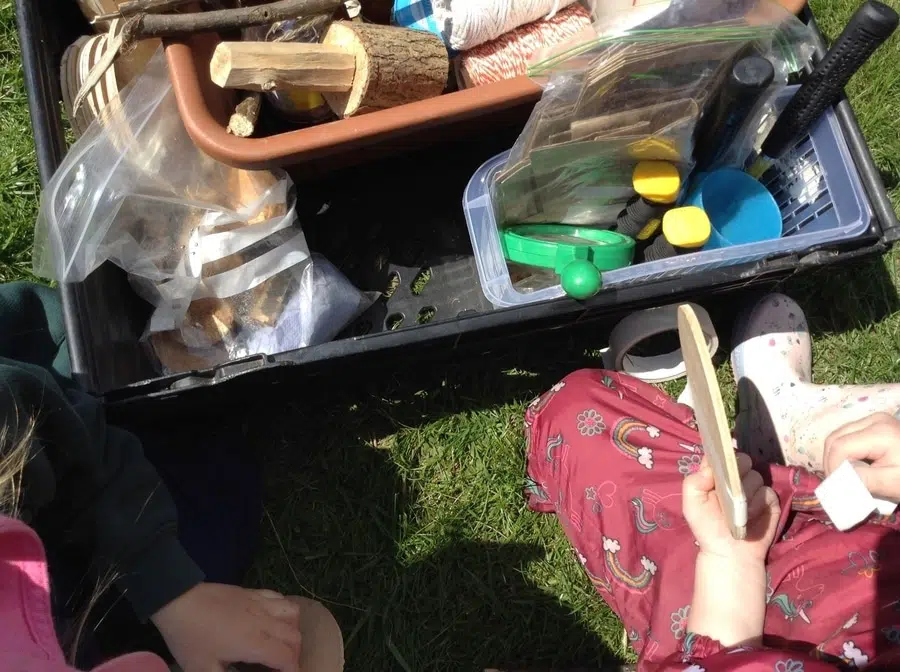Tool play is so important for children, and develops many key skills and abilities. Using tools in forest school allows children to experience danger in the form of risky equipment. You can find out many more examples of risky play in this article.
It helps them to manage risk, and become completely involved in the activity that they are doing – ‘in the zone’ in sporting terms. But what activities can young children from the age about three or four upwards do safely?
Some excellent forest school tools activities include:
- Whittling sticks for the fire-pit
- Whittling sticks open-ended play
- Making dogs
- Making mobiles
- Using large bowsaw for cutting
- Cutting cord
- Cutting shrubs with a billhook
- Cut sticks with a billhook
- Malleting tent pegs in the ground
- Cutting firewood
Many forest school activities are open-ended, and the above activities have different contexts. With regards to supervision, it is best practice to closely supervise all activities using dangerous tools, usually in a one-to-one or one-to-two ratio.
There are many advantages to allowing children to engage in this form of play, and you can read the full 21 benefits of risky play here.
Here are the activities in full:

1.Whittling Sticks With Potato Peelers
The idea here is to find sticks that could be used to cook with. A common activity is to cook marshmallows on the end of pointy sticks over a fire.
You can teach the children how green sticks are the best for this purpose, as they will not catch fire over the flames. Find some green sticks that are not fully dried, and then use potato peelers to peel the bark off the end of them. The pointier the ends are the better for spiking the marshmallows, so keep on whittling!
2. Whittling Sticks Open-Ended
This same technique of whittling with potato peelers can also be used in a much more open-ended context. For this the children can find any kind of sticks – green or dried.
They whittle them, and of course the stick could take on different meaning for them. It could be a spear, a wand, a bow, a wizard’s staff – whatever they think.
3.Making Dogs
This is so simple, but an activity that children really love. First, find a branch at least a couple of inches thick.
Then lay the branch over a log on the floor (or in a vice if you have one). If you have no vice, the adult will normally hold the log in place, keeping your hands well away from the blade. The child uses a bow-saw to cut off a section of the log. This is the dog. You then can wind string round and round the log and tie for a lead.
It is surreal how some children will walk the dog around for a huge amount of time, and practise looking after it.
4. Making Mobiles
Some outdoor mobiles look really beautiful. For these you need some cord, a small hand-drill and some smallish slices of wood.
Children place the wood slices on a flat log (or something similar), and then drill holes in the wood.
You loop cord through the holes and try to intertwine the slices into a hanging mobile.
5. Using Large Bow-Saws
These can be used by two children at a time. Large bow-saws are ideal for cutting wood that is a minimum of an inch and a half thick. It is also good for sawing branches that are long and will not move much when sawing, or for sawing branches off trees that are lying on the ground.
Two children put both hands on either side of the bow-saw, and cooperate to saw the branch with a forwards and backwards movement.
This is one of the classic activities of traditional forest school. If you’d like to learn about what other types of activities children engage in within forest school then read this essential guide.
6. Cutting With A Knife
I tend to use a Mora Fixed Blade Knife for this. These knives are very flexible in their use. Here are some great activities you can try:
- Cutting cord for a mobile or for den making
- Cutting undergrowth and long grass
- Cutting sticks
- Cutting string for tying together things such as sticks
Most activities will require two hands, which always needs more coordination and concentration. One hand will be holding the object, the other will be cutting.
7. Billhook For Cutting Shrubs
A billhook looks like a mini-sickle. It is a small curved metallic blade that can be used for cutting all sorts of
They are used in both forestry as well as agriculture.
Children can use the billhooks for a range of purposes. They are good for cutting long grass or hay.
They are also great for cutting through shrubs or weeds. This activity is great for teaching children about the kinds of plants that are OK to cut down, and those that it is best to leave alone.
You can also use a billhook for cutting string and wool.
8. Billhooks and Mallets
Billhooks can also be used alongside mallets. One excellent use is to cut wood using them. This is great for fire-wood, or for crafting a size of stick for another purpose.
You put the billhook on the stick that you want to cut, and then hit it with the mallet, cutting the stick.
9. Malleting
You can use a wooden mallet for a range of purposes. You can buy a mallet, or some settings use mallets that have been carved out of a single slab of wood. You can buy these, or some settings have created their own.
Mallets can be used for all sorts of purposes. Some of the most common are:
- Hammering tent pegs into the ground. These can be used to build dens or wooden A-frames
- Hammering wooden stakes into the ground
- Hitting sticks into the ground when building A-frames or dens
10.Cutting Fire-Wood With A Bow-Saw
Collecting fire-wood is one of those instinctive and simple activities that humans have been carrying out for millennia. Children can be taught about the types of sticks that will burn, and the type that will not. In general, look out for dry sticks, and ones that are not green on the inside.
When they have found sticks, they can saw some of the larger ones up into sections or in half. They can use a bow-saw, either independently or using a larger bow-saw with a partner in a pair.
The Benefits Of Using Tools
There are so many benefits of using tools. Some of these include:
- Teamwork – children talk with others about their ideas and negotiate and allocate roles
- They learn to cope with stress
- It helps them to form positive attitudes
- It helps them to experience a level of fear in a reasonably controlled environment. This helps them to not become risk adverse, and also leads to a level of exhilaration if they overcome that fear.
- It improves their creativity
- They develop their motor skills, coordination and physical development.
- It is fun! That three letter word that is sometimes torn out from the heart of the early years
- It is great for mental health. It gets children concentrating, interested, and proud of their achievements
If you are interested in the full benefits of risky play for children, I would recommended you to read my in-depth article – 21 Benefits of Risky Play For Children.
Conclusion
Using dangerous tools gives children that thrill of excitement, and strongly develops their concentration and engagement. It also gives them lasting skills for the future, as well as a sense of purpose and achievement when they have created something amazing, or made something they have imagined. Give these tool activities a go, and just remember if you supervise closely everything should go fine.
If you’ve found this article beneficial, then why not check out one of these:
